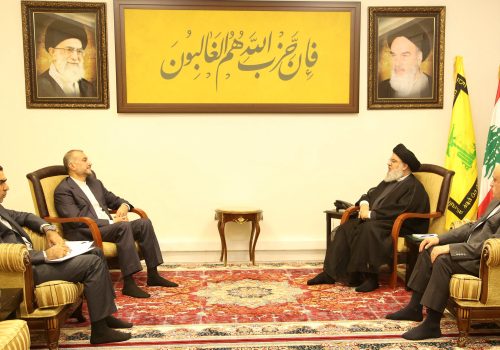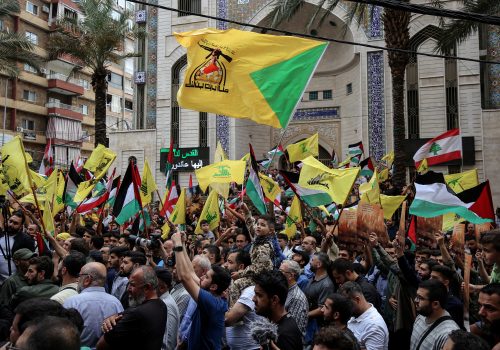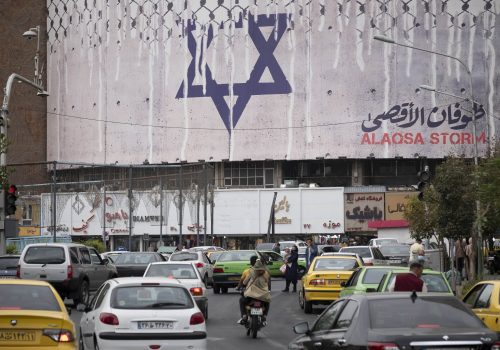The Gaza war raises questions about the future of Iran’s Resistance Axis
After meeting with Lebanese Hezbollah’s leader Hassan Nasrallah in Beirut, Iranian Foreign Minister Hossein Amir-Abdollahian said in a live broadcast to state television on October 16, “If we don’t defend Gaza today, we must defend our own cities.” He added, “Mr. Nasrallah also said that if we don’t take immediate action, we will have to fight with the Zionist forces in Beirut tomorrow.”
Amir-Abdollahian’s statement could serve as a reminder of how senior Iranian officials publicly justified their country’s involvement in the Syrian civil war after the emergence of the Islamic State of Iraq and el-Sham (ISIS). At a 2015 meeting with families of Iranian soldiers who died fighting in Syria and Iraq, Supreme Leader Ayatollah Ali Khamenei reportedly said, “They went to fight the enemy, and if they did not fight, this enemy would be inside the country… If they were not stopped, we would have to fight them in Kermanshah and Hamedan,” referring to provinces in western Iran.
For years, Iran has considered itself to be located in a very problematic environment, where it is surrounded by failed or weak states and faces a foreign presence that could pose a threat to its national security. Historical experience has contributed to Iran’s security considerations. The most recent historical trauma embedded in the Iranian national memory is its bloody eight-year war with Iraq (1980-1988).
It was Iraqi dictator Saddam Hussein who started the war against the nascent Islamic Republic and initiated the use of weapons of mass destruction, including chemical weapons, against targets in Iran. Yet, most countries in the world, including most of the Arab countries, supported Iraq. This reality strengthened the determination of the clerical establishment to do everything they could to ensure that this trauma would not happen again.
The desire to ensure the survival of the regime against threats from home and abroad is the first objective of the Islamic Republic that shapes its concept of security, with its first line of defense in that context being the Islamic Revolutionary Guard Corps (IRGC). The United States’ 2003 invasion of Iraq, the 2011 civil war in Syria, and the 2014 rise of ISIS have only heightened Iran’s concerns in the last two decades. These events laid the foundation for establishing the “Resistance Axis,” which is a significant tool for Iran to deter its enemies and expand its influence and power beyond its borders. This regional bloc, under its leadership, also includes the Bashar al-Assad regime in Syria, Hezbollah in Lebanon, Shia militias in Iraq, Syria, and Yemen, as well as Hamas and Palestinian Islamic Jihad.
This development can be seen as an expression of the concept that has taken root in the Iranian political and security elite over the past two decades: an increasing importance on expanding Iran’s activities and influence far beyond its political and geographical borders to enhance its ability to deal with external threats.
As an expression of the desire to neutralize threats as early as possible, Iran adopted the “forward defense” strategy (also known as the “offensive defense” strategy) in the last decade; it’s based on containing threats to Iran’s national security by dealing with its enemies as far away from its borders as possible. The Deputy Chief of the General Staff of the Iranian Armed Forces, Masoud Jazaeri, explained the need for the concept of forward defense by pointing out that Iran’s enemies, which are led by the United States, have adopted a military strategy based on imposing a “siege” on the Islamic Republic. As a result, it is incumbent upon Iran to break through this siege wherever it exists. He claimed that one of the methods used by the Americans and the “enemies of the revolution” was to increase their presence in Iran’s neighboring countries. If Iranians do not fight outside the borders of their country, they will be forced to fight within its borders. It is impossible to wait for the enemies and then deal with them; they must be stopped halfway.
The forward defense concept is closely intertwined with the “strategic depth” concept, which constitutes an essential element of Iran’s strategy and serves to compensate for its limited conventional military capabilities. Although this concept is not new, its significance has heightened over the past decade due to the regional upheaval following the 2011 Arab Spring.
Establishing the Resistance Axis has enhanced Iran’s capacity to extend its regional strategic depth. This involves strengthening groups that are loyal to Iran and committed to its anti-Zionist and anti-American ideology and strategy, establishing military bases for Resistance Axis groups and forging alliances with like-minded countries. The aim of achieving strategic depth is to enable Iran to broaden the battleground against its enemies beyond its territorial borders, creating defensive lines far from its borders. This strategy seeks to diminish Iran’s strategic isolation, act as a deterrent against potential attacks from Israel and the United States, and provide Tehran with the capability for a second strike in the event of an attack against it.
The Gaza war presents the first significant test of the level of cooperation present among the elements of the Iran-led Resistance Axis. This is not the first time that the degree of mutual commitment between the front members has been tested. The escalating events at Israel’s borders in Passover in April—particularly the tensions on the Temple Mount and the activation of the Gaza, Lebanon, and Golan Heights arenas by Hamas—were effectively leveraged by Iran and its proxies as an opportunity to promote the concept of the “convergence of the arenas” and to enhance the balance of deterrence vis-à-vis Israel. However, for the first time, the Gaza war now poses a major threat to one of the main components of the Resistance Axis. Therefore, it represents a significant test of its ability to deter Israel.
Since the outbreak of the war on October 7, Iran has intensified its threats towards Israel. However, Iran appears to be hesitant to open a full-scale front between Hezbollah and Israel, as this could exact a heavy toll on Hezbollah and perhaps even Iran itself. It could also potentially lead to American military intervention. Statements by senior Iranian officials indicate that Iran does not necessarily view deploying Hezbollah into an all-out campaign against Israel as the sole and immediate response option. At this stage, Iran seems to prefer taking action against Israel through pro-Iranian Shia militias from Iraq, Syria, and Yemen.
Nevertheless, Tehran’s assessments and considerations may evolve as the Gaza war continues, especially in the event of Israeli military successes that could threaten the survival of Hamas or its ability to maintain effective control over the Gaza Strip. The dilemma facing Iran is not a simple one. On the one hand, there is the fear of sacrificing Hezbollah’s strategic capabilities and risking a confrontation with the United States. On the other hand, there is the fear of the collapse of Hamas and a shift in the regional balance of power to the detriment of Iran and the Resistance Axis.
Whether Iran decides to escalate the war or not, the conflict in Gaza represents a seismic event, with strategic implications for Gaza and the entire Middle East. Neutralizing Hamas’ capabilities may impact not only the power dynamic between Israel and Hamas in Gaza, but also the future balance of power in the Middle East, which is contested by the Iran-led Resistance Axis and a coalition of more moderate international and regional forces.
At this juncture, Iran may find satisfaction in the achievements of Hamas and present them as another manifestation of Israel’s weakness and the strength of the Resistance Axis. Iranian officials also emphasize reports regarding the freezing of contacts for normalization between Saudi Arabia and Israel as further evidence of the success of efforts to thwart this development. However, Iran is also aware that a potential military achievement for Israel and the defeat of Hamas could lead to the emergence of a new political reality on the day after the war, potentially undermining Iran’s regional position.
While Iran might be able to maintain its position even without Hamas in control of Gaza, in the aftermath of the conflict, Iran may realize that Hezbollah (considered Tehran’s preferred strategic arm in the region) could also face repercussions, even if the latter refrains from engaging in an all-out confrontation with Israel and manages to preserve its arsenal of rockets and missiles.
There are already voices in Israel advocating for a change in the security situation vis-à-vis Hezbollah in the aftermath of the war. For example, Israel Beytenu party leader Avigdor Liberman urged more decisive action against Hezbollah in Lebanon. “We can’t finish a war without tossing Hezbollah beyond the Litani [River],” the hawkish former defense minister said, adding that “no one will return to those villages” near the border with Israel, which has now largely been evacuated by the Lebanese. The Israeli Defense Forces, which are currently focused on the fighting in the Gaza Strip, have already killed dozens of Hezbollah fighters since the outbreak of the war and caused considerable damage to Hezbollah positions along the border and its military installations.
After the war, Iran will need to ask itself whether a more limited and restrained network of its proxies is sufficient to safeguard its essential security interests in a changing regional reality. If the answer to this question is negative, Iran may reevaluate another strategic measure it has developed in recent decades to deter its enemies and ensure its survival: the nuclear option. Khamenei has considered a military nuclear threshold capability to provide Iran with an effective deterrent against its enemies and serve as insurance for the continued survival of the regime.
So far, Iran has not decided to accelerate to nuclear weapons. However, the heightened sense of threat may prompt a shift in Iran’s nuclear strategy based on the assessment that it can no longer solely rely on its proxies nor be content with the nuclear threshold for deterring its enemies. Since President Donald Trump’s withdrawal from the nuclear agreement in 2018, Tehran’s violation of its commitments to the deal has led to notable progress in the Iranian nuclear program, bringing Iran closer to the threshold of nuclear weapons capability. Iran has already changed its nuclear strategy in the past. It could do so again.
Dr. Raz Zimmt is a research associate at the Institute for National Security Studies and the Alliance Center for Iranian Studies at Tel Aviv University. He is also a veteran Iran watcher in the Israeli Defense Forces. Follow him on X: @RZimmt.
Further reading
Thu, Oct 19, 2023
Israel misread Iran’s way of war. A proper understanding could help predict Hezbollah’s next moves.
IranSource By David Daoud
Iran—through Hezbollah—has spent almost two decades and considerable effort and funds building the Gaza Strip into the Axis of Resistance’s Southern Front against Israel.
Wed, Oct 11, 2023
Hamas’s attack on Israel was straight out of Hezbollah’s playbook
MENASource By David Daoud
The genesis of Operation Al-Aqsa Flood appears to originate with Hezbollah, at least in part. The pressing question now is what will Hezbollah do next?
Fri, Oct 13, 2023
What do Iranians think of Israel? Their views might surprise you
IranSource By
Anyone familiar with Iranian society knows that anti-Israel attitudes have mostly failed to go beyond the most vociferous supporters of the regime despite years of attempted forced indoctrination.
Image: A man holds an Iranian flag while standing next to a portrait of former commander of the Islamic Revolutionary Guard Corps, General Qasem Soleimani, before Hezbollah's Secretary-General, Hassan Nasrallah, gives a speech, in Tehran on November 3, 2023. Hassan Nasrallah spoke in Beirut about the Israeli army's attack on Gaza and warned Israel about a possible attack on Lebanon. (Photo by Morteza Nikoubazl/NurPhoto)


